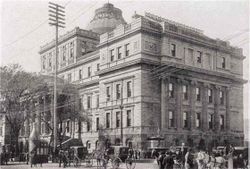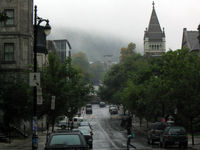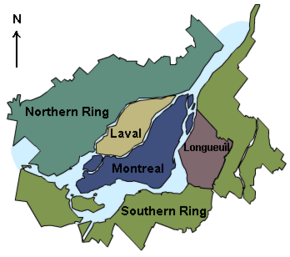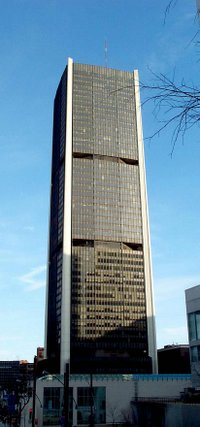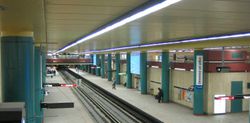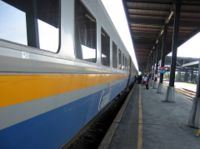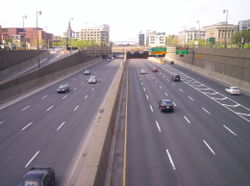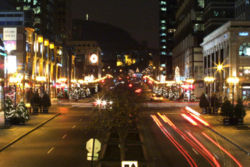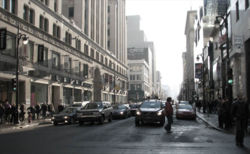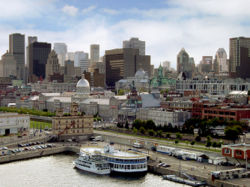Montreal
2007 Schools Wikipedia Selection. Related subjects: North American Geography
| City of Montreal, Québec, Canada (Ville de Montréal, Québec, Canada) | ||||
|
||||
| Motto: Concordia Salus | ||||
| Coordinates: | ||||
|---|---|---|---|---|
| Country | Canada | |||
| Province | Quebec | |||
| Founded | 1642 | |||
| Established | 1832 | |||
| City Mayor | Gérald Tremblay | |||
| Area | ||||
| - City | 366.02** km² (141.3 sq mi) | |||
| - Metro | 4,047 km² (1,563 sq mi) | |||
| Population | ||||
| - City (2001) | 1,583,590** | |||
| - Density | 4,326.5/km² (11,205.6/sq mi) | |||
| - Urban | 3,015,665 | |||
| - Metro | 3,635,700 | |||
| Metro population est. 2005 | ||||
| Time zone | Eastern (EST) ( UTC-5) | |||
| - Summer ( DST) | EDT ( UTC-4) | |||
| Postal code span | H | |||
| Area code(s) | 514/438/ 450 | |||
| **Area and city population figures reflect the new 2006 demerged city territory | ||||
| Website: Ville de Montréal | ||||
Montreal, or Montréal in French, ( pronounced /ˌmʌntɹiˈɑːl/ in Canadian English, /mɔ̃ʀeal/ in International French, and /mɒ̃ɾeal/ in some varieties of Quebec French) is the second largest city in Canada and the largest city in the province of Quebec. It is the largest French speaking city in the Western Hemisphere, and is the French language hub outside of France. At the 2001 Canadian Census, 1,588,590 people lived on the current territory of the city of Montreal proper (new 2006 demerged territory/the island of Montreal is about 1,900,000). The population of the Montreal Census Metropolitan Area (also known as Greater Montreal Area) is estimated at 3,720,000 in 2006. Montreal is ranked as the 15th-largest metropolitan area in Northern America and 77th in the world. In 2006, both Traveler's Digest and AskMen.com ranked Montreal as the number one city in the world to live in for its culture, architecture, history and ambience.
History
French rule
Huron, Algonquin, and Iroquois have inhabited the Montreal area for some eight thousand years. The first European to reach the area was the French Jacques Cartier, when he entered the village of Hochelaga on the Island of Montreal on October 2, 1535.
Seventy years later, Samuel de Champlain arrived on the island but the village of Hochelaga no longer existed. In 1611 he established La Place Royale, a fur trading post on the Island of Montreal, but the local Iroquois successfully defended their land. The first permanent European settlement on the Island of Montreal was created in 1639 by a French tax collector named Jérôme Le Royer. Missionaries Paul Chomedey de Maisonneuve, Jeanne Mance and a few French colonists founded the Ville Marie Roman Catholic mission on May 17, 1642.
Ville Marie became a centre for the fur trade and a base for further exploration into New France. The Iroquois continued their attacks on the settlement until a peace treaty (the Great Peace, see French and Iroquois Wars and ) was signed in 1701. After the Great Peace, the French had in fact eliminated the last Amerindian threat to their settlements. Montreal and the seigneuries nearby (Terrebonne, Lachenaie, Boucherville, Lachine, Longueuil, ...) could then start developing without the fear of Iroquois raids.
However, war was soon to resume, this time with a formidable new enemy, namely the British. Ville-Marie remained French until 1760, when Pierre François de Rigaud, Marquis de Vaudreuil-Cavagnal surrendered it to the British army under Jeffrey Amherst. Fire destroyed one quarter of the town on May 18, 1765.
British rule
The Treaty of Paris in 1763 ended the Seven Years' War and ceded New France to the Kingdom of Great Britain. For several months American Revolutionists held the city in 1775; they left peacefully. By this time, now named Montreal, the city had started to grow from English-speaking immigration mostly from the Thirteen colonies. Soon after, the golden era of fur trading began in the city with the advent of the locally owned North West Company, the main rival to the primarily British Hudson's Bay Company.
Montreal was incorporated as a city in 1832. The city's growth was further spurred by the opening of the Lachine Canal, which permitted ships to bypass the unnavigable Lachine Rapids south (upstream) of the island. Montreal was the capital of the United Province of Canada from 1844 to 1849, which attracted more English-speakers (now referred to as Anglophones) to the city, making the two linguistic groups roughly equal in size. The resulting increased English-speaking community built one of Canada's first universities, McGill, and the wealthy merchant classes began building large mansions at the foot of Mont Royal.
During British rule Montreal surpassed Quebec City, and became the seat of financial and political power for both English and French speaking communities of Canada, a position it held for many years.
After Confederation (1867)
In 1852, Montreal had 58,000 inhabitants; by 1860, it was the largest city in British North America and the undisputed economic and cultural centre of Canada. With the annexation of neighbouring towns between 1883 and 1918, Montreal became a mostly Francophone city again.
After World War I, the Prohibition movement in the United States turned Montreal into a haven for Americans looking for alcohol. Unemployment remained high in the city, and was exacerbated by the Stock Market Crash of 1929 and the Great Depression. Canada began to recover from the Great Depression in the mid-1930s, when skyscrapers such as the Sun Life Building began to appear.
During World War II, Mayor Camillien Houde protested against conscription and urged Montrealers to ignore the federal government's registry of all men and women. Ottawa was furious over Houde's insubordination and put him in a prison camp until 1944, when the government was forced to institute conscription (see Conscription Crisis of 1944).
Hundreds of Catholic churches were built as the population grew. This fact explains a few of Montreal's former nicknames: "the city of Saints" and "La ville aux cent clochers" (the city of a hundred belltowers).
Post-war
After Montreal's population surpassed one million in the early 1950s, Mayor Jean Drapeau laid down plans for the future development of the city. These plans included a new metro system and an underground city, the expansion of Montreal's harbour, and the opening of the Saint Lawrence Seaway. New buildings were built on top of old ones in this time period, including Montreal's two tallest skyscrapers up to then: the 43-storey Place Ville-Marie and the 47-storey Tour de la Bourse. Two new museums were also built, and finally in 1966, the metro opened, along with several new expressways.
The city's international status was cemented by Expo '67 and the Summer Olympics in 1976.
In the mid-1970s, following the October Crisis and also due to economic and political shifts after the election of the sovereigntist Parti Québécois, Montreal's linguistic and ethnic composition underwent a period of transition greater than the norm for urban centres, as many (mostly Anglophone) Montrealers migrated to other provinces. Bill 101 was passed in 1977 and gave primacy to French as Quebec's (and Montreal's) only official language for government, the main language of business and culture, and enforced the use of French for public signage and business communication.
Throughout the recessions of the 1980s and well into the 1990s, Montreal experienced a relatively slow rate of job growth compared to other major Canadian cities. By the mid 90s, though, Montreal's economy stabilized, and new companies and institutions have risen to fill the usual business and financial niches. As the city celebrated its 350th anniversary in 1992, the construction of two new skyscrapers: 1000 de La Gauchetière and 1250 René-Lévesque was begun. Montreal's favourable economic conditions allowed further improvements in infrastructure, with the expansion of the metro system, construction of new skyscrapers and the development of a ring road around the island.
Montreal was merged with the 27 surrounding municipalities on the Island of Montreal on 1 January 2002. The merger created a unified city of Montreal which covered the entire Island of Montreal. This move proved to be unpopular, and several former municipalities totalling 13% of the population of the Island of Montreal voted to leave the newly unified city in separate referendums which took place on 20 June 2004. The demerger took place on 1 January 2006, leaving 16 municipalities on the Island of Montreal, including Montreal.
Geography
Overview
Montreal is located in the southwest of the province of Quebec, approximately 270 kilometres (168 miles) southwest of Quebec City, the provincial capital, and 190 kilometres (118 mi) east of Ottawa, the federal capital. It also lies 539 kilometres (335 mi) northeast of Toronto,and 610 kilometres (380 mi) north of New York City.
The city rests on the Island of Montreal at the confluence of the Saint Lawrence and Ottawa Rivers. The port of Montreal lies at one end of the St. Lawrence Seaway, which is the river gateway that stretches from the Great Lakes into the Atlantic Ocean. Montreal is bordered by the St. Lawrence river on its south side, and by the Rivière des Prairies on the north. The city is named after the most prominent geographical feature on the island, a three-head hill called Mount Royal.
Climate
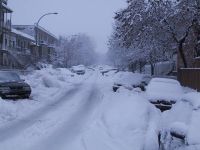
Montreal lies at the confluence of several climatic regions and thus the climate in Montreal varies greatly.
Precipitation is abundant with an average snowfall of 2.14 metres (84 in) per year in the winter. It snows on average more in Montreal, than Moscow, Russia. Regular rainfall throughout the year averages 897 millimetres (35.3 in). Each year the city government spends more than C$50 million on snow removal. Summer is the wettest season statistically, but it is also the sunniest.
The coldest month of the year is January, which has a daily average temperature of −10.4 °C (13 °F) — averaging a daily low of −14.9 °C (5.2 °F). Due to wind chill, the perceived temperature can be much lower than the actual temperature and wind chill factor is often included in Montreal weather forecasts. The warmest month is July which has a daily average temperature of 20.9 °C (69.6 °F) — averaging a daily high of 26.3 °C (79.3 °F). The lowest temperature ever recorded was −37.8 °C (−36.0 °F) on 15 January 1957 and the highest temperature ever was 37.6 °C (99.7 °F) on 1 August 1975. Moderate to high humidity is common in the summer. In spring and autumn, rainfall averages between 55 and 94 millimetres (2.2 and 3.7 in) a month. Some snow in spring and autumn is normal. Similarly, late heat waves as well as " Indian summers" are a regular feature of the climate.
| Weather averages for Montreal, Quebec | |||||||||||||
| Month | Jan | Feb | Mar | Apr | May | Jun | Jul | Aug | Sep | Oct | Nov | Dec | Year |
|---|---|---|---|---|---|---|---|---|---|---|---|---|---|
| Avg high °F | 21 | 24 | 35 | 51 | 65 | 73 | 79 | 76 | 66 | 54 | 41 | 27 | 51 |
| Avg low °F | 7 | 10 | 21 | 35 | 47 | 56 | 61 | 59 | 50 | 39 | 29 | 13 | 36 |
| Avg high °C | -6 | -4 | 1 | 10 | 18 | 22 | 26 | 24 | 18 | 12 | 5 | -2 | 10 |
| Avg low °C | -13 | -12 | -6 | 1 | 8 | 13 | 16 | 15 | 10 | 3 | -1 | -10 | 2 |
| Precipitation (in) | 2.8 | 2.6 | 2.8 | 2.9 | 2.7 | 3.3 | 3.4 | 3.6 | 3.3 | 3.0 | 3.5 | 3.4 | 37.3 |
| Precipitation (cm) | 7 | 6 | 7 | 7 | 6 | 8 | 8 | 9 | 8 | 7 | 8 | 8 | 94 |
| Source: Weatherbase Nov 2006 | |||||||||||||
Botanics
Despite its widely varying climate, the Montreal region supports a diverse array of plants and wildlife. The maple is one of the most common trees and the sugar maple in particular is an enduring symbol of Montreal and Quebec, thanks to the production of maple syrup.
Demographics
| Ethnic origin | Population | Percent |
|---|---|---|
| Canadian | 1,885,085 | 55.76% |
| French | 900,485 | 26.63% |
| Italian | 224,460 | 6.63% |
| Irish | 161,235 | 4.76% |
| English | 134,115 | 3.96% |
| Scottish | 94,705 | 2.80% |
| Jewish | 80,390 | 2.37% |
| Haitian | 69,945 | 2.06% |
| Greek | 55,865 | 1.65% |
| German | 53,850 | 1.59% |
Origins
According to Statcan, in 2001, the city of Montreal had 1,583,590 inhabitants. However, 3,635,700 live in the metropolitan area as of 2005 up from 3,426,350. In the 2001 census, children under 14 years of age (618,855) constituted 18.06 percent, while inhabitants over 65 years of age (442,720) numbered 12.92 percent of the total population. Some 13.55 perent of the population are member of a visible minority (non-white) group. Blacks contribute to the largest minority group, numbering some 140,000 (4.12% of Montreal inhabitants), which is the second largest community of Blacks in Canada, after Toronto. Other groups, such as Arabs (now estimated at 100,000 people), Latin American, South Asian, and Chinese are also large in number. (Chart on ethnicity on the left includes multiple responses
Religions
The city of Montreal is overwhelmingly Roman Catholic, which is unusual for many North American cities of its size. However, this is merely due to the fact that many people associate with Catholicism as part of their cultural heritage; in reality, church attendance is the lowest in Canada. Montreal society is one of the most secular in North America. Some 84.56 percent of the total population is Christian, largely Roman Catholic (74.51%), which is largely due to French, Italian and Irish origins. Protestants which include Anglican, United Church, Lutheran and other number 7.02%, while the remaining 3.03% consists mostly of Orthodox Christians, fuelled by a large Greek population. Due to the large number of non-European cultures, there is a diversity of non-Christian religions. Islam is the largest non-Christian group with some 100,000 members, the second largest concentration of Muslims in Canada, constituting 2.96%. The Jewish community in Montreal has a population of 90,000 . In some neighbourhoods of Montreal such as Cote St. Luc, Hampstead, and Dollard des Ormeaux, Jewish people consitute the majority , or a substantial part of the population. Other religions such as Buddhism, and Hinduism are present, but much smaller.
Languages
The predominant language in Montreal is French, although other langages are spoken by some residents. In 2001, 67.29% spoke French as a first language, followed by English speakers numbering 12.07%. The remaining percentage (20.64%) is made up mostly of other Indo-European languages such as Italian speakers (100,000), Portuguese, Greek, German, Spanish, Polish, Russian, Romanian, and Hindi. Other languages include Arabic, Armenian, and Chinese (note that many of these speakers speak French as a second language). On the island of Montreal itself, these numbers change and Francophones constitute only 53% of the population, with the balance of 18% Anglophones and 29% Allophones. A remarkable and unique feature of Montreal throughout Canada, as noticed by Statistics Canada, is the working knowledge of both French and English by a majority of its residents. Also, more immigrants speak French than ever, a trend that started after the introduction of the French language legislation during the 1970s.
Administration
The head of the city government in Montreal is the mayor, who is first among equals in the City Council. The current mayor is Gérald Tremblay, who is a member of the Union des citoyens et des citoyennes de l'Île de Montréal (English: Montreal Island Citizens Union). The city council is a democratically elected institution and is the primary decision-making authority in the city. It currently consists of 73 members from all boroughs of the city. The Council has jurisdiction over many matters, including public security, agreements with other governments, subsidy programs, the environment, urban planning, and a three-year capital expenditure program. The City Council is also required to supervise, standardize or approve certain decisions made by the borough councils.
Reporting directly to the City Council, the executive committee exercises the decision-making powers appropriate to it and is responsible for preparing various documents including budgets and by-laws, submitted by the City Council for approval. The decision-making powers of the executive committee cover, in particular, the awarding of contracts or grants, the management of human and financial resources, supplies and buildings. It may also be assigned further powers by the City Council.
Standing committees are the council's instruments for public consultations. They are responsible for the public study of pending matters and for making the appropriate recommendations to the council. and its five constituent parts. They also review the annual budget forecasts for departments under their jurisdiction. A public notice of meeting is published in both French and English daily newspapers at least seven days before each meeting. All meetings include a public question period. The current standing committees, of which there are seven, have terms lasting two years. In addition, the City Council may decide to create special committees at any time. Each standing committee is made up of seven to nine members, including a chairman and a vice-chairman. The members are all elected municipal officers, with the exception of a representative of the government of Quebec on the public security committee.
The city of Montreal is only one component of the larger Communauté Métropolitaine de Montréal (English: Montreal Metropolitan Community or MMC), which is in charge of planning, coordinating, and financing economic development, public transportation, garbage collection, etc., across the metropolitan area of Montreal. The president of the CMM is the mayor of Montreal. The CMM covers 3,839 square kilometres (1,482 sq mi), with 3,635,700 inhabitants in 2005.
Montreal now constitutes its own region of Quebec.
Culture
Arts
The cultural heart of classical art and the epicenter of many summer festivals, the Place-des-Arts is a complex of different concert and theatre halls surrounding a large open-spaced square in downtown. The Place-des-Arts harbors the headquarters of Montreal Symphony Orchestra (MSO), which perform in its halls regularly. The MSO is one of the top performance troops in North America, most remembered for the quality performance of the repertoire of Maurice Ravel. Since 2006, the MSO has a new conductor, the American Kent Nagano. L'orchestre metropolitain and the chamber orchestra I Musici de Montréal are two other well-regarded Montreal orchestras. Also performing home at Place-des-Arts is the Opéra de Montréal, the most prestigious opera company in Montreal, and the city’s chief ballet company Les Grands Ballets Canadiens. In contemporary dance, Montreal has been a leading turning plate, particularly in the 80s. Internationally recognized avant-garde dance troupes such as La La La Human Steps, O Vertigo, and the Fondation Jean-Pierre Perreault have toured the world and worked with international popular artists during videos and concerts. The intelligent integration of multi-discipline arts in choreography of these troops has paved the way to the success of the Montreal-based Cirque du Soleil.
Montreal is the cultural centre of Quebec, and of French-speaking North America as a whole. The city is hub for French language television productions, radio, theater, film, multimedia and print publishing. It is therefore not surprising that the local musical, literature, and theater scenes in Montreal are dominated by French-speaking artists. The Quartier Latin is a neighbourhood crowded of cafés animated by this literary and musical activity. The local English-speaking artistic community nevertheless contributes dynamically to the culture of Montreal, and intense collaborations exist between all Montreal communities. The result is a dynamic musical scene, ignited by the presence of numerous musical festivals, that melts different musical styles and traditions, of which Arcade Fire is a good example. English theatre struggled but survived with the Centaur Theatre. Ethnic theatre, by the 70s, began to be a force with the Black Theatre Workshop, the Yiddish Theatre established at the Saidye Bronfman Centre and the Teesri Duniya Theatre.
Festivals
See Festivals and parades in Montreal
The plaza on Place-des-Arts is the home of the most important events during several musical festivals, including the Montreal International Jazz Festival and Montreal Francofolies, a festival of French-speaking song artists. During the seven-to-ten days that last each of the two festivals, shows are held in a wide variety of venues, from relatively small clubs to the large halls of Place des Arts. Some of the outdoor shows are held on cordoned-off streets while others are on terraced parks. The most popular festival, in terms of attendance, is the Just For Laughs Festival. A comedy festival held in both languages, it features comedians, humorists, and stand-ups from all over the world. The Montreal Fireworks Festival also attracts a lot of attention. On the evenings of competition, tens of thousands of people watch the fireworks for free on their roofs or from locations nearby the competition. Other festivals in Montreal include Pop Montreal, The Fringe festival and Nujaz.
Night life and restaurants
Montreal's night life is particularly dynamic. The most active neighborhoods then are rue St-Laurent, Downtown ( Crescent Street, Sainte-Catherine Street), Quartier Latin ( Saint Denis Street), and Plateau Mont-Royal. Restaurants in Montreal are particularly rich of the contributions from the different cultural communities that live in the city. Jewish culinary contributions extended to two of the world-renowned smoked meat sandwiches and Montreal style bagels.
Economy
Montreal is an important centre of commerce, industry, culture, finance, and world affairs.
Montreal industries include telecommunications, pharmaceuticals, high technology, finance, textile and clothing manufacturing, higher education, electronic goods, software engineering, building and city engineering, transportation devices, printed goods, aerospace and tobacco.
Montreal is a major port city along the Seaway, a deep-draft inland waterway links it to the industrial centres of the Great Lakes. It is still the largest inland port in the world. As one of the most important ports in Canada, it remains a trans-shipment point for grain, sugar, petroleum products, machinery, and consumer goods. For this reason, it is the railway hub of Canada and has always been an extremely important rail city; it is the eastern terminus of the Canadian Pacific Railway and home to the headquarters of the Canadian National Railway.
The headquarters of the Canadian Space Agency are located in Longueuil, southeast of Montreal. Montreal also hosts the headquarters of the International Civil Aviation Organization (ICAO, a United Nations body); the World Anti-Doping Agency (an Olympic body); and the International Air Transport Association (IATA); as well as some 60 other international organizations in various fields.
Montreal is also a centre of film and television production, primarily but not exclusively for French Canadian productions. The headquarters and five studios of the Academy Award-winning documentary producer National Film Board of Canada can be found here, as well as the head offices of Telefilm Canada, the national feature-length film and television funding agency. Given its eclectic architecture and broad availability of film services and crew members, Montreal is a popular filming location for feature-length films, and sometimes stands in for European locations. The city is also home to several distinct film and music festivals which contribute significantly to its economy.
Sports
The biggest sport following in Montreal clearly belongs to hockey – and the city is famous for its hockey-hungry fans. The Montreal Canadiens are one of the Original Six NHL teams, and boast the greatest number of Stanley Cup championships at 24.
Montreal is also the site of two high-profile racing events each year: the Canadian Grand Prix, and the Molson Indy Montreal of the Champcars Series. Both races take place at the Circuit Gilles Villeneuve on Île Notre-Dame. As of 2006, NASCAR is also rumoured to be in talks with city officials and the track promoter about a possible racedate, most likely for the Busch Series at first and possibly the Nextel Cup down the road.
The Montreal Alouettes of the CFL draw packed crowds at the small but picturesque Molson Stadium. Although university football has long been popular with Anglo Montrealers, who support the McGill Redmen, Concordia Stingers, and Bishop's Gaters, enthusiastic Francophone crowds also enjoy the University of Montreal's Carabins "en français".
The city's current USL First Division soccer team is called the Montreal Impact.
In 2006, Montreal was expected to attract some 16,000 LGBT athletes, who will participate in the first-ever GLISA World Outgames. The Outgames are being hailed as the largest international event in the city of Montreal since the 1976 Olympics.
The Montreal games of the FIFA U-20 World Cup Canada 2007 will be held at the Olympic Stadium. This will be the 16th edition of the soccer championship
Montreal was the home of a major league baseball team, the Montreal Expos, named after the 1967 World's Fair, and began playing in Montreal in 1969. However, due to lack of support, dismal attendance and other financial factors, the team moved to Washington, DC in 2005, where it was re-named the Washington Nationals.,
Montreal has been slated to have a Can-Am League team beginning in 2008.
Current professional franchises
| Club | League | Sport | Venue | Established | Championships |
|---|---|---|---|---|---|
| Montreal Canadiens | NHL | Hockey | Bell Centre | 1909 | 24 |
| Montreal Alouettes | CFL | Football | Percival Molson Memorial Stadium Olympic Stadium |
1946-87 1996-today |
7 |
| Montreal Impact | USL | Soccer | Complexe sportif Claude-Robillard | 1993 | 2 |
| Montreal Matrix | ABA | Basketball | Centre Pierre Charbonneau | 2005 | 0 |
| Montreal Mission | NRL | Ringette | Various | 2004 | 0 |
Recreational sports
Beaches
There are five beaches around the island.
- Cap St. Jacques Nature Park
- Bois-de-L’Ile Bizard Nature Park
- Jean Drapeau Park Beach
- Pointe Calumet Beach Club
- Oka Beach
The Quebec Ministry of Environment tests the beaches for pollutants, Rated “A” to “D”.
Cycling
Montreal has an well developed network of bicycle paths.
Bike rentals are available at the Old Port of Montreal (also quadricycles, inline skates, children trailers, and segways).
Transportation
Montreal is a transportation hub for eastern Canada, with well-developed air, road, rail, and maritime links to the rest of Canada, as well as the United States and Europe.
Public transit
The city is served by a network of buses and subway and commuter trains that extend across and off the island. The current subway and bus system is operated by the Société de transport de Montréal, and buses off-island are operated by the Société de transport de Laval and the Réseau de transport de Longueuil in their respective territories. The commuter rail system is managed and operated by the Agence métropolitaine de transport, and extends across several municipalities.
The STM bus network consists of 169 daytime and 20 night-time service routes, and provides adapted transport and limited wheelchair-accessible buses.
Each station of the Montreal Metro was designed by different architects with individual themes and features original artwork, and the trains themselves run on rubber tires, making the system quieter than most. It has 65 stations spread out along four lines. It was inaugurated in 1966 and completed in time for Expo 67. The project was initiated by Montreal Mayor Jean Drapeau, who also brought the Olympics to Montreal in 1976. The metro system has long had a station on the South Shore in Longueuil, and is currently being extended into Laval, north of Montreal. Three new stations are scheduled to be opened in 2007, several months late and several hundred million dollars over budget.
Passenger rail
VIA Rail, which is headquartered in Montreal, provides several rail services to other cities in Canada, particularly to Québec City and Toronto with several trains daily.
Amtrak, the U.S. national passenger rail system also provides service to Montreal, operating its Adirondack daily between Montreal and New York City.
Most trains operate out of Gare Centrale.
Airports
Montreal has two international airports, one for passenger flights only, and the other for cargo. Montréal-Pierre Elliott Trudeau International Airport (formerly Dorval Airport, the name still used by locals) in the City of Dorval serves all commercial passenger traffic and is the headquarters for Air Canada and Air Transat. To the north of the city is Montréal-Mirabel International Airport in Mirabel, which was envisioned as Montreal's primary airport but which now serves only cargo flights. In 2005, Montreal-Trudeau was the third busiest airport in Canada. It handled 10.9 million passengers and is expected to handle 11.2 million in 2006. Trudeau airport serves 100+ destinations worldwide making it one of the most connected airports in North America.
Montreal-Trudeau is one of the few airports in the world that is prepared to handle the new Airbus A380, which is expected to begin service in 2007. Montreal is expecting to handle two of Air France's A380s and a Air France Boeing 747 every day. The A380 will initially be used on North Atlantic route services from Paris to Montreal.
Roads
Like many major cities, Montreal has a problem with vehicular traffic congestion, especially from off-island suburbs such as Laval on Île Jésus, and Longueuil on the southeastern shore. The width of the Saint Lawrence River has made the construction of fixed links to the southeastern shore expensive and difficult. Accordingly, there are only four road bridges (plus one road tunnel, two railway bridges, and a metro line), whereas the far narrower Rivière des Prairies is spanned by eight road bridges (six to Laval and two to the north shore).
Limited-access highways (Autoroutes)
The island of Montreal is a hub for the Québec Autoroute system, and is served by Québec Autoroutes A-10 (aka the Bonaventure Expressway on the island of Montreal), A-15 (aka the Decarie Expressway south of the A-40 and the Laurentian Autoroute to the north of it), A-13 (aka Autoroute Chomedey), A-20, A-25, A-40 (part of the Trans-Canada Highway system, and known as "The Metropolitan" or simply "The Met" in its elevated mid-town section), A-520, and A-720 (aka the Ville-Marie Autoroute). Many of these Autoroutes are frequently congested at rush hour. However, in recent years, the government has acknowledged this problem and is working on long-term solutions to alleviate the congestion, such as re-routing traffic and expanding lanes. (Osirus Azer, "Montreal's Traffic Problems", 2006)
Street grid system
Since Montreal is on an island, the directions used in the city plan do not precisely correspond with compass directions, as they are oriented to the geography of the island. North and south are defined on an axis roughly perpendicular to the St. Lawrence River and the Rivière des Prairies: North is towards the Rivière des Prairies, and south is towards the St. Lawrence. East and west directions are defined as roughly parallel to the St. Lawrence River (which flows southwest to northeast) and the Rivière des Prairies. East is downstream, and west is upstream.
Saint Laurent Boulevard, also known as "The Main," divides Montreal into east and west sectors. Streets that cut across Saint Laurent Boulevard undergo a name change, in that Est (East) or Ouest (West) are appended to their names. Streets that do not cross the Main do not generally contain a cardinal direction at the end of their names. Address numbering begins in either direction at one (1) at Saint Laurent Boulevard, increasing in both directions away from the boulevard. On north-south streets, house numbers begin at the Saint Lawrence River and the Lachine Canal and increase to the north. Odd numbers are on the east or north sides of the street, with even numbers on the west or south sides. Numbered streets generally run north and south, and the street numbers increase to the east.
Education
With access to six universities and twelve junior colleges in an 8 kilometer (5 mi) radius, Montreal has the second highest concentration of post-secondary students of all major cities in North America. After the demerger, Montreal regains the "concentration" title.
English-language secondary public schools in the Greater Metropolitan Montréal Area are operated by the English Montreal School Board. The Lester B. Pearson School Board, Riverside School Board, Sir Wilfred Laurier School Board, and the New Frontiers School Board. French-language secondary public schools in Montreal are operated by the Commission scolaire de Montréal (CSDM).
The education system in the province of Quebec is slightly different from other systems in North America. Between the High School and University levels, there is an additional college level called " Cégep". It is at the same time a preparatory school (preparing students for admission at the University) and a technical school (offering courses which lead to technical diplomas and specializations). In Montréal, there are Cégeps offering courses in French (17) and in English (5). See List of Cégeps.
Francophone universities
- Université de Montréal
- École Polytechnique de Montréal
- HEC Montréal - École des Hautes Études Commerciales de Montréal
- Université du Québec
- Université du Québec à Montréal (UQÀM)
- École de technologie supérieure (ETS)
- École nationale d'administration publique (ENAP)
- Institut National de la Recherche Scientifique (INRS)
- Institut de tourisme et d'hôtellerie du Québec (ITHQ)
- Université de Sherbrooke (Located in Sherbrooke, campus in Longueuil)
- Université Laval (Located in Québec, campus in Longueuil)
English-language universities
- McGill University
- Desautels Faculty of Management
- Schulich School of Music
- Concordia University
- John Molson School of Business (JMSB)
Downtown Montreal
Downtown Montreal lies at the foot of Mount Royal, which is designated as a major urban park, and extends toward the St Lawrence River. The Downtown area contains dozens of notable skyscrapers — which, by law, cannot be higher than Mount Royal — including the aforementioned 1000 de La Gauchetière and 1250 René-Lévesque. The Tour de la Bourse (Stock Exchange Tower) is also a significant building in Montreal, and is home to the Montreal Exchange, that trades in derivatives such as futures contracts and options. The Montreal Exchange was the first stock exchange in Canada. In 1999 all stock trades were transferred to Toronto in exchange for an exclusivity in derivatives trading.
Place Ville-Marie, an I. M. Pei-designed cruciform office tower built in 1962, sits atop an underground shopping mall that forms the nexus of Montreal's underground city, one of the world's largest, with indoor access to over 1,600 shops, restaurants, offices, businesses, museums and universities, as well as metro stations, train stations, bus terminals, and tunnels extending all over downtown. The central axis for downtown is Saint Catherine Street, Canada's busiest commercial avenue. Other major streets include Sherbrooke, Saint-Denis, Peel, de la Montagne, de Maisonneuve and Crescent. The Montreal Skyline panorama includes two islands, Île Ste. Hélène and Ile Notre-Dame. The Notre Dame island hosts the Canadian Grand Prix and Formula One car races, as well as the Champ Car tournament. La Ronde is the biggest amusement park in Montreal and is located on Île Ste. Hélène. The Montreal Fireworks Festival is held there every summer.
The basic Skyline view may be seen from one of two lookouts on Mount Royal. The lookout at the Belevedere takes in downtown, the river, and the Montérégien Hills, and on clear days the Adirondack Mountains of Upstate New York or the Green Mountains of Vermont are visible. The view of eastern lookout on Remembrance Rd. sweeps out toward the Olympic Stadium, and beyond. Many tourists visit these lookouts.
Montreal is known for contrast between old and new architecture. The Maison des Coopérants (a 146 m / 479 ft tall building) and 1000 De La Gauchetière are located immediately behind the city's Anglican and Roman Catholic cathedrals. Much of Old Montreal has been maintained or restored to its original state. Old Montreal was a worldwide port, but shipping has been moved further east to the Port de Montreal site, leaving the Old Port/Vieux-Port as an historical area.
Old Montreal
Just southeast of downtown is Old Montreal (Vieux-Montréal), an historic area with such attractions as the Old Port, Place Jacques-Cartier, City Hall, the Marché Bonsecours, Place d'Armes, Pointe-à-Callière Museum, and the Notre-Dame de Montréal Basilica. Architecture and cobbled streets in Old Montreal have been maintained or restored to keep the look of the city in its earliest days as a settlement, and horse-drawn calèches help maintain that image. Old Montreal is accessible from the downtown core via the underground city and is served by several STM bus routes and metro stations, ferries to the South Shore and a network of bicycle paths.
Shipping has been moved further east to the Port de Montreal site, leaving the riverside area of Old Port/Vieux-Port adjacent to Old Montreal as a recreational and historical area now maintained by Parks Canada. The most recent trip to the North Pole departed from this port.
Underground City
Montreal's Underground City (French: La ville souterraine) is the set of underground city complexes in and around downtown. It is also known as the indoor city (ville intérieure), as not all of it is underground. With over 32 kilometres (20 mi) of tunnels spread over an area of twelve square kilometres (4.6 sq mi), the 60 residential and commercial complexes comprise 3.6 square kilometres (1.4 sq mi) of floor space, including 80% of all office space and 35% of all commercial space in downtown Montreal. Services include shopping malls, hotels, banks, offices, museums, universities, seven metro stations, two commuter train stations, a bus terminal and the Bell Centre hockey arena. There are more than 120 exterior access points to the underground city. Some 500,000 people use the underground city every day, especially to escape the traffic and/or Montreal's harsh winter. Because of the Underground City, Montreal is often referred to as "Two Cities in One."
Neighbouring municipalities
| North: Laval, Repentigny | ||
| West: Vaudreuil-Dorion, L'Île-Perrot | Montreal Demerged municipalities |
East: Longueuil, Saint-Lambert |
| South: Kahnawake, Brossard, Ste-Catherine, St-Constant |
Sister cities
|
|
|




